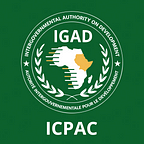Role of the Inter-Regional Platform for the management of desert locusts and other trans-boundary pests in the IGAD region
By Emebet A. Jigssa and Kenneth Mwangi with contributions from the IGAD Climate Change Technical Working Group
Due to similar agricultural practices and environmental conditions, countries in the Horn of Africa face comparable challenges in pest management. Pests like armyworms, desert locusts, and quelea birds can quickly migrate across borders and cause significant damage to crops and pastures, posing a serious threat to the region. Therefore, it is crucial to respond quickly and work together with efficient communication strategies and effective pest control measures to combat these transboundary infestations.
The Intergovernmental Authority on Development (IGAD) is a regional organization that focuses on enhancing economic integration, peace, and security. Among the key objectives of IGAD is addressing agricultural challenges, including those related to transboundary pest management, in the region.
To achieve this, IGAD promotes collaboration among member states to collectively combat transboundary pest threats and develop context-specific pest control strategies suited to each country’s unique circumstances.
Tackling transboundary pests such as desert locust outbreaks, not only within the region but globally, requires a comprehensive approach that encompasses vigilant monitoring, early warning systems, and effective intervention strategies. Collaborative efforts are instrumental in addressing these challenges. When faced with common challenges, the nations in the Horn of Africa often unite through regional bodies like IGAD for information exchange, joint research and coordinated responses to pest outbreaks through specialized institutions, as the case in the 2018–2021 Desert Locust invasion.
In 2021, IGAD initiated a three-year initiative (2021–2023) with funding from the World Bank. The objective isto establish and operationalize an Inter-Regional Platform for the Sustainable Management of Desert Locusts and other Trans-Boundary Pests within the IGAD region. The platform significantly enhances coordination, monitoring, surveillance, and pest control operations at various levels, from inter-regional to national. In addition, it aims to elevate early warning systems and expedite responses in IGAD member states. To ensure the successful implementation of this platform, IGAD is collaborating with the Desert Locust Control Organization for Eastern Africa (DLCO-EA).
Establishing and maintaining early warning systems are of paramount importance in promptly detecting and responding to pest outbreaks. Utilizing Additionally, using technologies such as satellite imagery, ecosystem modelling, and weather forecasts, these systems predict pest movements and provide advanced alerts to affected countries. IGAD, through its specialized institution IGAD Climate Prediction and Applications Centre (ICPAC), has developed tools such as the East Africa Hazards Watch to disseminate early warning information regarding desert locusts and other transboundary pests in the region. This platform works closely with DLCO-EA to operate a regional early warning system for pests and diseases, enabling member states to share crucial information and coordinate swift responses to emerging threats.
Capacity development is another essential aspect of combating pest challenges. Effective capacity development involves educating government actors, sector experts, media personnel, and other stakeholders through training programs and workshops on pest identification, monitoring, control methods, and crisis reporting training programs and workshops. Similarly, investing in research and development is crucial in combating these challenges. Research projects aimed at developing pest-resistant crop varieties and environmentally friendly pest control methods can provide innovative solutions and empower governments and institutions in the region to manage pests sustainably.
Furthermore, establishing and harmonizing regulatory frameworks for registration, importation, and the use of pesticides is crucial. This ensures that pesticides used in one country do not adversely affect neighboring nations through pesticide drift or contamination of shared water resources, promoting sustainable and responsible pest management practices across the region.
The region’s countries should have contingency plans as tools for national pest managment and resources to respond rapidly to pest outbreaks. This includes stockpiling pesticides and equipment for pest control and establishing emergency response teams. To strengthen joint pest management, carrying out surveillance programs at border regions to monitor pest movements and sharing this information among neighboring countries is needed. Establishing and maintaining a network of monitoring and surveillance systems that includes ground-based observations and satellite imagery is crucial.
Engaging local communities in pest management efforts is necessary for effective surveillance and control. Communities provide valuable information on pest outbreaks and participate in control efforts. Likewise, access to government funding and developmental support has significantly enhanced the capacity of East African countries to manage transboundary pests. International organizations, NGOs, and developmentagencies have picked a joint-action model to provide financial and technical assistance, and this approach is proving more fruitful for short-term and long-term transboundary pest management.
In summary, the Horn of Africa must engage in regional collaboration for managing and controlling pests that can harm agriculture and food security across borders. By working together, sharing information, aligning policies, and enhancing capabilities, the countries in this region can address the challenges presented by transboundary pests more effectively. Inter-regional cooperation, information exchange, and coordinated responses are key factors in effective pest management.
Organizations such as the Intergovernmental Authority on Development (IGAD), Desert Locust Control Organization for Eastern Africa (DLCO-EA), East African Community (EAC), International Centre of Insect Physiology and Ecology (ICIPE), Centre for Agriculture and Bioscience International (CABI) and the Food and Agriculture Organization (FAO) play pivotal roles in promoting cooperation, monitoring, and pest control efforts to mitigate the impact of pests on the region’s agriculture and livelihoods.
Related topics:
IGAD member states to have joint database for pests outbreaks
Government, IGAD Collaborate On Transboundary Pest Management
IGAD Regional Ministerial meeting on risk transfer transboundary Pest Management
IGAD Ministerial Conference Renews Push to Eradicate the Desert Locust
Horn of Africa agriculture ministers pledge harmonized action on invasive pests
